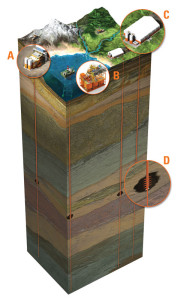Good well design helps mitigate solids settling in cuttings re-injection
Optimum tubing size, slurry rheology, well trajectory, completion design all can minimize risk of plugging
By Salamat Gumarov, Talgat Shokanov, Steve Simmons, Viacheslav Anokhin and Said Benelkadi, M-I SWACO, a Schlumberger company
Attention has been drawn to the practice of cuttings re-injection as an environmentally friendly technique for the drill cuttings and waste disposal. Engineers have studied the practice with the objective of determining best practices and lessons learned for good well design.
With increasing environmental regulations, various methods and techniques have emerged in drilling waste management. Different technologies are used depending on local regulations, infrastructure and operational requirements. Methods also depend on whether oil-based mud or water-based mud is used. In some areas, drilling waste is thermally treated to remove hydrocarbon content and then disposed at a landfill. Cases of treatment with bacteria (bioremediation) or fixation (mixing with soil and lime) can be also encountered.
The idea to inject cuttings back into the formation was launched in the late 1970s to early 1980s but didn’t emerge as a distinct technology until the 1990s.
Cuttings re-injection (CRI) wells can be classified into two types: dedicated injection (drilled for CRI and completed with tubing) and annular injection (often production or water injection wells where the intermediate annulus is used for cuttings slurry injection).
Over the past decade, general guidelines for safe cuttings reinjection have been put forward in terms of injection formation selection, operation planning and procedures.
Well trajectory
CRI wells are often drilled with high deviation to place the injection zone away from producing wells. Higher deviation accelerates solids settling in the wellbore. In designing the injection well path, a compromise between offset and settling risk has to be sought.
As a best practice, various well trajectory options should be examined for settling severity via numerical simulations using FEM-based code. Another implication is alignment between fractures that are often vertical with the wellbore. Field stress orientations are rarely known, so minimizing the well deviation in the injection interval below 30° is a good practice.
From experience, dedicated disposal wells drilled with deviation as high as 60° in the middle section and 35° inclination over the injection interval operated with no plugging issues. In one case, an annular injection well with 72° deviation at the injection casing shoe accommodated 1.3 million bbl of drilling waste over 11 years without plugging.
Tubular selection
Correct tubing size selection will prevent or minimize solids settling by providing a sufficient flow velocity and flow regime inside the tubing. Turbulent or transitional flow inside the tubing are preferred to avoid settling while laminar flow is undesirable. Tubing that is too large will lead to accelerated settling. On the other hand, tubing that is too small will amplify erosion and frictional pressure losses.
A reasonable median must be selected. In the discussed case, 4.5-in. or smaller tubing were found to provide acceptable flow while injecting at 4-5 bbl/min – a common injection rate.
A further step to minimize settling risk is by ensuring adequate rheology of slurry by lab tests. In addition to optimum slurry properties, these tests should define the maximum allowable static residence time of the slurry in the wellbore. The final step is ensuring the proper displacement of the wellbore after slurry injections by solids-free fluids so no solids are left in the wellbore.
Experience has shown that solids settling and subsequent plugging of perforations is the most frequent complication during CRI. Proper initial design of the CRI well can avoid this risk by ensuring optimum tubular selection, safe well trajectory and completion scheme.
Completion scheme

Other important considerations with implications for CRI well performance are location of tubing tail and rat-hole. Tubing tail should be placed at an optimum depth above the perforations. A longer distance will provide additional contingency injection intervals that can be employed without well re-completion in case of failure in the main perforated interval. However, the excessive length of the casing section will translate into high settling risk in this interval and large well volume. Field experience with placing the tubing tail below perforations lead to plugging the well bottom and is thus not recommended in CRI wells.
The rat-hole below perforations is another critical feature. It will accommodate any settled solids so they will not cover the perforations immediately. Although the rat-hole will eventually be filled with settled solids as observed in the field, it will provide additional safety for well performance. In the field case, the CRI well with no rat-hole below 6 m of perforated interval was plugged in three months.
Perforations should meet industry best practices for fracturing stimulation in terms of hole size, phasing and shot density. In terms of perforation interval, 4-10 m of perforation interval works well in most CRI wells.
Cement used for the CRI well must be top quality to avoid channeling and to withstand pressure/temperature cycles. For contingency purposes, the intermediate casing shoe can be left not cemented so the intermediate annulus can be used for backup injection in case of failure in the tubing injection zone.
Well injection is the most critical asset in the CRI project. Planning and designing it right from the early stages will allow avoiding many costly setbacks. For example, a single plugging of offshore CRI well can lead to multimillion losses due to lost rig-time, clean-up and waste alternative disposal.
This article is based on IADC/SPE 167987, “Drill Cuttings Re-Injection Well Design and Completion: Best Practices and Lessons Learned,” presented at the 2014 IADC/SPE Drilling Conference & Exhibition, Fort Worth, Texas, 4–6 March 2014.




